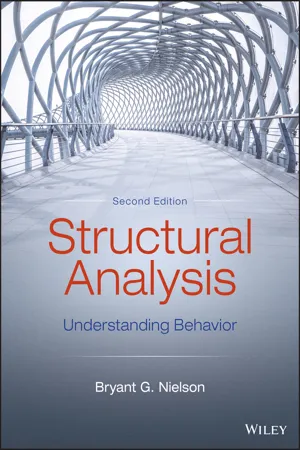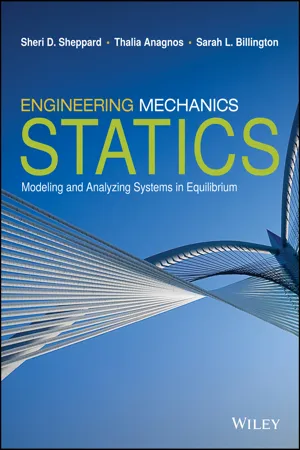Technology & Engineering
Zero Force Members
Zero force members are structural elements within a truss that carry no force when the entire truss is in equilibrium. These members can be identified by analyzing the geometry and load distribution of the truss. They play a crucial role in simplifying the analysis of truss structures, as they can be removed without affecting the overall stability of the truss.
Written by Perlego with AI-assistance
Related key terms
1 of 5
3 Key excerpts on "Zero Force Members"
- eBook - PDF
Structural Analysis
Understanding Behavior
- Bryant G. Nielson(Author)
- 2022(Publication Date)
- Wiley(Publisher)
SUMMARY Two zero-force members exist in this truss: BF and CG . 172 PLANE TRUSSES EXAMPLE 7.5 The zero-force members have been identified for the truss shown. Verify these findings. Q U I C K N O T E Member IJ is a zero-force member, but joint J will never meet either of the two defined conditions. Rather, identification of this zero-force member relies on you understanding the principle behind all conditions. This means that a member is zero force if there is no other member or force that has a component in the direction of the member in question. For example, once we find that JK is zero force, joint J has no X component force. This means that IJ (only has a horizontal component) must also be zero. A quick equilibrium equation at the joint verifies this. A E D B F C G H I J K L P P P SOLUTION STRATEGY Make sure both conditions are well understood. Scan all 12 joints of the given truss following the procedure outlined in this text. SOLUTION The following table is presented with the findings of each joint condition. Joint Condition Finding A External force None B External force None C External force None D External force None E Condition #1 N EK = 0 F Four members None G Condition #2 N FG = N LG = 0 H Condition #1 N BH = 0 I Five members None J External force None K Five members None L Condition #1 N FL = 0 The first scan through the truss revealed the existence of five zero-force members. After removing the zero-force members, a sequence of subsequent scans reveals that all members to the right of joints D and J are zero-force members. Q U I C K N O T E When using the method of sections there are three equations of equilibrium that are available for each section ( ∑ F X , ∑ F Y , and ∑ M Z ). As such, you must ensure that you do NOT end up with more than three unknown bar forces when making a cut. - eBook - PDF
Engineering Mechanics: Statics
Modeling and Analyzing Systems in Equilibrium
- Sheri D. Sheppard, Thalia Anagnos, Sarah L. Billington(Authors)
- 2017(Publication Date)
- Wiley(Publisher)
The basic building block of a planar truss is a triangle, composed of three two-force members connected by pins. The triangle is the simplest rigid structure that can be created with two-force members; by rigid we mean that the structure is internally stable. If a truss is not planar, it is a space truss. The basic building block of a space truss is a tetrahedron composed of two-force members. 8.6 JUST THE FACTS 497 Analyzing Trusses by the Method of Joints Analyzing Trusses by the Method of Sections The two procedures for finding the forces carried by two-force members in a truss are the method of joints and the method of sections, or some combination of the two procedures. Both methods assume that the reason for analyzing the system has been defined and that information about the problem has been documented. The method of joints consists of considering equilibrium of the truss as a whole (in order to find the support forces acting on the truss), and of each of the pin connections that make up the truss. The method of sections consists of considering equilibrium of the truss as a whole, and of portions of the truss with a boundary cut through the two-force members themselves. Identifying Zero-Force Members In undertaking either the method of joints or the method sections, it is useful to identify zero-force members as part of the analysis. These are two-force members that for a particular loading of the truss carry zero force. Two common cases in which zero-force members occur are Case 1 (Two-Member Zero-Force Joint) 1. Only two two-force members are connected at the joint. 2. No external forces are applied to the pin joint. 3. The members connected to the joint do not have the same line of action. Case 2 (Three-Member Zero-Force Joint) 1. Three two-force members are pinned together at the pin connection. 2. No external loads are applied to the pin connection. - eBook - PDF
- Aslam Kassimali(Author)
- 2019(Publication Date)
- Cengage Learning EMEA(Publisher)
142 CHAPTER 4 Plane and Space Trusses 5 5 F F y L F F z L yAB AB AB AB zAB AB AB AB and the resultant force F AB is given by F F F F AB xAB yAB zAB ( ) ( ) ( ) 2 2 2 5 1 1 The analysis of space trusses can be expedited by identifying the zero-force members by inspection. Two common types of member arrangements that result in zero-force members are the following: 1. If all but one of the members connected to a joint lie in a single plane and no external loads or reactions are applied to the joint, then the force in the member that is not coplanar is zero. 2. If all but two of the members connected to a joint have zero force and no external loads or reactions are applied to the joint, then unless the two remaining members are collinear, the force in each of them is also zero. The first type of arrangement is shown in Fig. 4.31(a). It consists of four members AB , AC , AD , and AE connected to a joint A . Of these, AB , AC , and AD lie in the xz plane, whereas member AE does not. Note that no external loads or reactions are applied to joint A . It should be obvious that in order to satisfy the equilibrium equation 5 0 ∑ F y , the y component of F AE must be zero, and therefore 5 F AE 0 . The second type of arrangement is shown in Fig. 4.31(b). It consists of four members AB , AC , AD , and AE connected to a joint A , of which AD and AE are zero-force members, as shown. Note that no external loads or reactions are applied to the joint. By choosing the orientation of the x axis in the direc-tion of member AB , we can see that the equilibrium equations 5 0 ∑ F y and 5 0 ∑ F z can be satisfied only if 5 0 F AC . Because the x component of F AC is zero, the equation 5 0 ∑ F x is satisfied only if F AB is also zero. FIG. 4.30 Copyright 2020 Cengage Learning. All Rights Reserved. May not be copied, scanned, or duplicated, in whole or in part. Due to electronic rights, some third party content may be suppressed from the eBook and/or eChapter(s).
Index pages curate the most relevant extracts from our library of academic textbooks. They’ve been created using an in-house natural language model (NLM), each adding context and meaning to key research topics.


